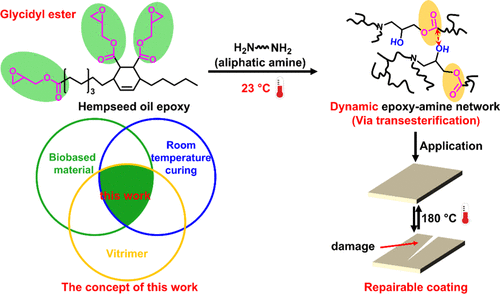当前位置:
X-MOL 学术
›
ACS Sustain. Chem. Eng.
›
论文详情
Our official English website, www.x-mol.net, welcomes your feedback! (Note: you will need to create a separate account there.)
Hempseed Oil-Based Covalent Adaptable Epoxy-Amine Network and Its Potential Use for Room-Temperature Curable Coatings
ACS Sustainable Chemistry & Engineering ( IF 8.4 ) Pub Date : 2020-09-16 , DOI: 10.1021/acssuschemeng.0c05223 Shuai Zhang 1 , Tuan Liu 1 , Cheng Hao 1 , Anna Mikkelsen 1, 2 , Baoming Zhao 1 , Jinwen Zhang 1
ACS Sustainable Chemistry & Engineering ( IF 8.4 ) Pub Date : 2020-09-16 , DOI: 10.1021/acssuschemeng.0c05223 Shuai Zhang 1 , Tuan Liu 1 , Cheng Hao 1 , Anna Mikkelsen 1, 2 , Baoming Zhao 1 , Jinwen Zhang 1
Affiliation

|
Conventional thermoset coatings are prepared from petrochemical feedstocks, which are nonrenewable, and the resulting coatings are not repairable. To extent the service life and meet the sustainable demands, it is desirable to develop repairable coatings prepared from renewable feedstocks. Dynamic covalent chemistry can impart thermosetting polymers the repairability. However, such alternative polymers that are also room-temperature curable are rare. In this work, a room-temperature curable epoxy vitrimer is introduced by curing a mixture of hempseed oil-based glycidyl ester-type epoxy (HOEP) and a bisphenol A-based digycidyl ether-type epoxy with diethylenetriamine (DETA). The resulting cross-linked network possesses abundant ester bonds and hydroxyl groups, which can undergo dynamic transesterification reactions at elevated temperatures and provide typical vitrimer behaviors such as stress relaxation and reparability to the cured resin. Coatings of this resin system on tin plates prepared at room temperature exhibit satisfactory glass transition temperature (>40 °C), scratch hardness (5H), gouge hardness (6H), adhesive strength (5B), and solvent resistance. The renewable HOEP accounts for up to 67.5 wt % in the composition. This work has demonstrated a simple method for the preparation of a room-temperature curable epoxy vitrimer using a glycidyl ester epoxy as a co-monomer and an aliphatic amine as the hardener, which is readily pluggable into current epoxy commercial products.
中文翻译:

大麻油基共价自适应环氧胺网络及其在室温固化涂料中的潜在用途
常规的热固性涂料是由石油化学原料制备的,该原料是不可再生的,并且所得的涂料是不可修复的。为了延长使用寿命并满足可持续需求,期望开发由可再生原料制备的可修复涂料。动态共价化学可以赋予热固性聚合物以可修复性。但是,这种还可以在室温下固化的替代聚合物很少。在这项工作中,通过将大麻油基缩水甘油酯型环氧树脂(HOEP)和双酚A基二环己基醚型环氧树脂与二亚乙基三胺(DETA)的混合物固化,引入了室温可固化的环氧三聚体。所得的交联网络具有丰富的酯键和羟基,它可以在高温下进行动态酯交换反应,并提供典型的三聚体行为,例如应力松弛和对固化树脂的可修复性。该树脂体系在室温下制备的镀锡板上的涂层表现出令人满意的玻璃化转变温度(> 40°C),划痕硬度(5H),凿硬度(6H),粘合强度(5B)和耐溶剂性。可再生的HOEP占组合物中高达67.5重量%。这项工作已经证明了使用缩水甘油酯环氧树脂作为共聚单体和脂肪族胺作为硬化剂来制备室温可固化的环氧玻璃微晶的简单方法,该方法很容易插入当前的环氧商品中。在室温下制备的马口铁板上该树脂体系的涂层表现出令人满意的玻璃化转变温度(> 40°C),划痕硬度(5H),凿硬度(6H),粘合强度(5B)和耐溶剂性。可再生的HOEP占组合物中高达67.5重量%。这项工作已经证明了使用缩水甘油酯环氧树脂作为共聚单体和脂肪族胺作为硬化剂来制备室温可固化的环氧玻璃微晶的简单方法,该方法很容易插入当前的环氧商品中。该树脂体系在室温下制备的镀锡板上的涂层表现出令人满意的玻璃化转变温度(> 40°C),划痕硬度(5H),凿硬度(6H),粘合强度(5B)和耐溶剂性。可再生的HOEP占组合物中高达67.5重量%。这项工作已经证明了使用缩水甘油酯环氧树脂作为共聚单体和脂肪族胺作为硬化剂来制备室温可固化的环氧玻璃微晶的简单方法,该方法很容易插入当前的环氧商品中。
更新日期:2020-10-05
中文翻译:

大麻油基共价自适应环氧胺网络及其在室温固化涂料中的潜在用途
常规的热固性涂料是由石油化学原料制备的,该原料是不可再生的,并且所得的涂料是不可修复的。为了延长使用寿命并满足可持续需求,期望开发由可再生原料制备的可修复涂料。动态共价化学可以赋予热固性聚合物以可修复性。但是,这种还可以在室温下固化的替代聚合物很少。在这项工作中,通过将大麻油基缩水甘油酯型环氧树脂(HOEP)和双酚A基二环己基醚型环氧树脂与二亚乙基三胺(DETA)的混合物固化,引入了室温可固化的环氧三聚体。所得的交联网络具有丰富的酯键和羟基,它可以在高温下进行动态酯交换反应,并提供典型的三聚体行为,例如应力松弛和对固化树脂的可修复性。该树脂体系在室温下制备的镀锡板上的涂层表现出令人满意的玻璃化转变温度(> 40°C),划痕硬度(5H),凿硬度(6H),粘合强度(5B)和耐溶剂性。可再生的HOEP占组合物中高达67.5重量%。这项工作已经证明了使用缩水甘油酯环氧树脂作为共聚单体和脂肪族胺作为硬化剂来制备室温可固化的环氧玻璃微晶的简单方法,该方法很容易插入当前的环氧商品中。在室温下制备的马口铁板上该树脂体系的涂层表现出令人满意的玻璃化转变温度(> 40°C),划痕硬度(5H),凿硬度(6H),粘合强度(5B)和耐溶剂性。可再生的HOEP占组合物中高达67.5重量%。这项工作已经证明了使用缩水甘油酯环氧树脂作为共聚单体和脂肪族胺作为硬化剂来制备室温可固化的环氧玻璃微晶的简单方法,该方法很容易插入当前的环氧商品中。该树脂体系在室温下制备的镀锡板上的涂层表现出令人满意的玻璃化转变温度(> 40°C),划痕硬度(5H),凿硬度(6H),粘合强度(5B)和耐溶剂性。可再生的HOEP占组合物中高达67.5重量%。这项工作已经证明了使用缩水甘油酯环氧树脂作为共聚单体和脂肪族胺作为硬化剂来制备室温可固化的环氧玻璃微晶的简单方法,该方法很容易插入当前的环氧商品中。



























 京公网安备 11010802027423号
京公网安备 11010802027423号